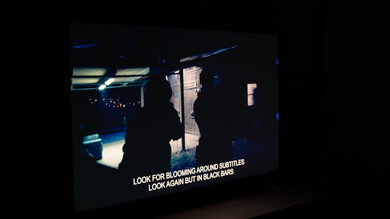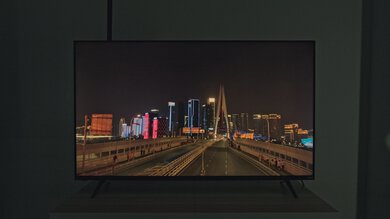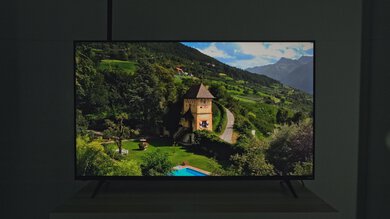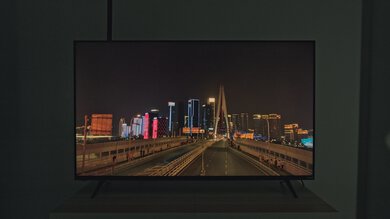The Vizio M6 Series Quantum 2022, also known simply as the M6 or MQ6, is a budget 4k TV released in 2022 as part of Vizio's 2023 lineup. It's a simpler variant of the Vizio M Series Quantum X 2022. This TV replaces the Vizio M6 Series Quantum 2021 and has many of the same features, like the Vizio SmartCast system, variable refresh rate (VRR) support, and eARC support. It's available in a wide range of sizes, from 43 to 75 inches, so you'll likely find the right size for your needs.
Our Verdict
The Vizio M6 is alright for most uses. It's mediocre for watching movies in a dark room, as it lacks a local dimming feature to improve dark scene performance. It also has problems upscaling lower-resolution content like from DVDs, and if you watch 4k HDR content, it doesn't get bright enough to make highlights pop. It's also mediocre for watching TV in a bright room as it doesn't get bright enough to fight glare. On the other hand, it's decent for gaming thanks to its low input lag and decent response time, and it supports a few advanced gaming features like VRR.
-
Fantastic native contrast ratio.
-
Decent reflection handling.
-
Trouble upscaling lower-resolution content.
-
No local dimming feature.
-
Narrow viewing angle.
The Vizio M6 is mediocre for watching TV shows in well-lit rooms. It has decent reflection handling, but it's so dim that it can't overcome glare in a bright room. It also struggles to clear up low-quality or low-resolution content, so it's disappointing for streaming shows from low-quality sources or for watching series sets on DVD. The Vizio SmartCast system supports most of the common streaming apps, but it feels slow and buggy at times.
-
Decent reflection handling.
-
Trouble upscaling lower-resolution content.
-
Narrow viewing angle.
-
Low peak brightness.
The Vizio MQ6 is mediocre for watching sports. It has a decent response time, so there's little blur behind fast-moving objects. Unfortunately, it has a narrow viewing angle that makes the image look washed out from the sides, so it's not ideal for watching the big game with a large group of friends. It can't handle glare, either. Finally, it has very limited picture processing capabilities, so it's not a good choice if you watch sports from cable boxes as it doesn't upscale lower-resolution content properly.
-
Decent reflection handling.
-
Decent response time.
-
Trouble upscaling lower-resolution content.
-
Narrow viewing angle.
-
Low peak brightness.
The Vizio MQ6 is decent for gaming. It has low input lag for a responsive feel and has VRR support to reduce screen tearing. It also has a decent response time, resulting in relatively little motion blur behind fast-moving objects. However, it's limited to a 60Hz panel and HDMI 2.0 bandwidth, so it can't take full advantage of the PS5 or Xbox Series X.
-
Fantastic native contrast ratio.
-
Decent response time.
-
Low input lag.
-
Limited VRR range.
-
Only max refresh rate of 60Hz.
The Vizio M6 is alright for watching movies in a completely dark room. It has high native contrast and good black uniformity, so dark scenes look good overall, but it lacks a local dimming feature to improve the TV's dynamic range. It displays a wide range of colors in HDR, but it doesn't get bright enough to make those colors look vivid and for highlights to pop, so overall, HDR adds very little.
-
Fantastic native contrast ratio.
-
Wide HDR color gamut.
-
No local dimming feature.
-
Only removes 24p judder from apps.
-
Doesn't make highlights pop.
The Vizio M6 is decent for gaming in HDR, but only thanks to its gaming performance. It delivers a decent gaming experience thanks to its low input lag, decent response time, and VRR support. It also displays deep blacks and has a wide color gamut for HDR but lacks a local dimming feature. Sadly, it doesn't deliver a satisfying HDR experience as it can't get bright enough to make highlights pop and colors look vivid, so HDR adds very little to the overall gaming experience.
-
Fantastic native contrast ratio.
-
Good black uniformity.
-
Decent response time.
-
Low input lag.
-
No local dimming feature.
-
Limited VRR range.
-
Only max refresh rate of 60Hz.
-
Doesn't make highlights pop.
The Vizio MQ6 is decent for PC use. Its low input lag delivers a responsive desktop experience, and it has a decent response time, too. Chroma 4:4:4 is displayed properly with all supported resolutions, which is essential for clear text from a PC, but there are some issues displaying a native 4k signal that you can notice if you sit close. Also, if you sit too close, the edges of the screen look washed out due to its narrow viewing angle.
-
Decent reflection handling.
-
Decent response time.
-
Low input lag.
-
Displays proper chroma 4:4:4.
-
Narrow viewing angle.
-
Low peak brightness.
-
Only max refresh rate of 60Hz.
- 6.7 Mixed Usage
- 6.2 TV Shows
- 6.4 Sports
- 7.4 Video Games
- 6.5 HDR Movies
- 7.7 HDR Gaming
- 7.4 PC Monitor
Changelog
- Updated Jul 08, 2025: We uploaded the latest brightness measurements and uniformity photos for the Accelerated Longevity Test.
- Updated Apr 17, 2025: We uploaded the latest brightness measurements and uniformity photos for the Accelerated Longevity Test.
- Updated Feb 11, 2025: We uploaded the latest brightness measurements and uniformity photos for the Accelerated Longevity Test.
- Updated Nov 20, 2024: We uploaded the latest brightness measurements and uniformity photos for the Accelerated Longevity Test.
- Updated Sep 11, 2024: We uploaded the latest brightness measurements and uniformity photos for the Accelerated Longevity Test.
Check Price
Differences Between Sizes And Variants
We tested the 55-inch Vizio M6 Series Quantum 2022 (M55Q6M-K04), and the results are also valid for the 43-inch, 65-inch, 70-inch, and 75-inch sizes. It's part of their M Series lineup released in 2022, which they label as their 2023 models. Note that this TV is different from the 50, 65, and 75-inch Vizio M Series Quantum X 2022 models, which the manufacturer advertises to have a higher refresh rate, get brighter, and have a local dimming feature.
| Size | Model Code |
|---|---|
| 43" | M43Q6M-K04 |
| 55" | M55Q6M-K04 |
| 65" | M65Q6M-K04 |
| 70" | M70Q6M-K03 |
| 75" | M75Q6M-K03 |
You can see the label for our unit here.
Compared To Other TVs
The Vizio MQ6 is an okay budget TV, but considering its upscaling issues and low peak brightness, there are better options available from brands like Hisense or TCL. It's also a bit of a downgrade compared to its predecessor, the Vizio M6 Series Quantum 2021, which is disappointing.
See our recommendations for the best budget TVs, the best 55-inch TVs, and the best smart TVs.
The Vizio M6 Series Quantum 2022 is a higher-end model than the Vizio V Series 2022, but the performance is very similar. The main difference is that the M6 has a wider color gamut thanks to its quantum dot technology, allowing it to display a wider range of colors. However, the V Series is still better in a few areas, like the peak brightness and color accuracy, and it removes 24p judder from Blu-rays, which the M6 can't do.
The Vizio M6 Series Quantum 2022 is the newer version of the Vizio M6 Series Quantum 2021, and it's a downgrade in a few areas. The 2022 doesn't remove 24p judder from native 24p sources like the 2021 model, which is disappointing for watching movies. However, motion looks better on the 2022 version because it has a quicker response time and it has a backlight strobing feature, which the 2021 model doesn't have.
The Vizio M7 Series Quantum 2021 is much better than the Vizio M6 Series Quantum 2022. The M7 has more features like local dimming which results in a better picture quality in dark scenes. It also gets brighter if you want to use it in a well-lit room, and if you watch movies it removes 24p judder from native apps and 24p sources, while the M6 can only remove it from native apps.
The Vizio M Series Quantum X 2022 is significantly better than the Vizio M6 Series Quantum 2022. The M Series Quantum X has much better picture quality, as it gets brighter in both SDR and HDR, and it has a decent full array local dimming feature, so bright highlights stand out. The M Series Quantum X is also better for gaming, as it has a higher native refresh rate and a wider variable refresh rate range.
The Hisense U6G is much better overall than the Vizio M6 Series Quantum 2022. It delivers better picture quality thanks to its local dimming feature and improved brightness, so highlights pop and colors look more vivid. The Hisense also doesn't have trouble upscaling lower-resolution content like on the Vizio, which is ideal if you watch DVDs or cable TV.
The TCL S546 is better overall than the Vizio M6 Series Quantum 2022. Thanks to its local dimming feature and higher peak brightness, the TCL delivers better overall picture quality.
Test Results
The Vizio MQ6 looks a lot like the Vizio M6 Series Quantum 2021. It's a simple-looking TV with an all-black body, mainly made of plastic. It looks surprisingly good for a budget model, with thin bezels and a modern design that looks good in most rooms.
The back of the TV is a mix of plastic and metal components. Because the inputs are placed towards the center of the TV, they're hard to reach, especially if you have it wall-mounted. Unfortunately, there isn't anything for cable management.
This TV doesn't have a local dimming feature, so it can't adjust the backlight of individual zones to brighten up highlights without impacting the rest of the image. But this means that there's no distracting flicker or brightness changes as bright highlights move between zones.
The Vizio MQ6 has poor HDR peak brightness. Scenes that are supposed to be bright aren't impactful, and since the TV lacks a local dimming feature, small bright highlights don't stand out.
These measurements are after calibrating the HDR white point with the following settings:
- Picture Mode: Calibrated Dark
- Tone Mapping: 50
- Color Temperature: Warm
- Gamma: 2.2
The HDR brightness in Game Mode is poor and looks the same as outside of Game Mode.
These measurements are after calibrating the HDR white point, with the following settings:
- Picture Mode: Calibrated Dark
- Game Low Latency: On
- Tone Mapping: 50
- Color Temperature: Warm
- Gamma: 2.2
This TV has excellent PQ EOTF tracking. It follows the target nearly perfectly, but as there's a sharp roll-off at the peak brightness, there are a lot of details lost in bright scenes. Due to its lack of a local dimming feature, dark shadow details are raised.
The Vizio MQ6 has disappointing SDR peak brightness. It doesn't get bright enough to fight glare, so it's best to use it in a dim or moderately-lit room. The higher-end Vizio M Series Quantum X 2022 gets significantly brighter.
These measurements are after calibration, with the following settings:
- Picture Mode: Calibrated Dark
- Backlight: 100
- Color Temperature: Warm
- Gamma: 2.2
This TV has an excellent color gamut thanks to its quantum dot technology. It displays a wide range of colors in the DCI-P3 color space used in most HDR content, and it also has good coverage of the Rec. 2020 color space. Unfortunately, the tone mapping is noticeably off in both color spaces, meaning most colors in HDR aren't displayed accurately.
The color volume is decent, but it struggles to display bright colors well, and it's limited by its incomplete color gamut.
This TV has mediocre accuracy in SDR before calibration. Most colors and the white balance are noticeably off. Luckily, the color temperature is very close to the 6500K target, and while gamma is brighter than the 2.2 target, it's only slightly off.
The accuracy after calibration to the 6500K white point is fantastic. It's easy to calibrate the white balance and gamma, but because the colors were so inaccurate before calibration, they're still slightly off after calibration.
See our full calibration settings here.
The Vizio MQ6 has okay gray uniformity. There are noticeable issues with backlight bleed and dirty screen effect that can get distracting with large areas of uniform colors, particularly when watching sports. Even with near-dark scenes, there's noticeable backlight bleed.
This TV has excellent gradient handling in HDR. There's some noticeable banding in dark shades of gray, but everything else looks nearly perfect.
This TV uses a BGR sub-pixel structure, which doesn't affect image quality, but it can negatively affect text clarity when using the TV as a PC monitor. You can read more about it here. It also has dithering in blue pixels, which negatively impacts the 4k upscaling as some images aren't as sharp.
This TV has a decent response time. Motion looks good for the most part, and while there's a bit of blur trail behind fast-moving objects, it's minimal with brighter objects. However, it has a slow response time in dark transitions, leading to black smearing with darker objects.
This TV uses pulse width modulation to dim its backlight at any Backlight level below its max and in any picture mode. Considering how dim the TV is, it's best to set it at its max backlight level to avoid flicker, but the flicker is high enough that it likely won't bother you if you're sensitive to flicker. However, it can also cause image duplication.
There's an optional backlight strobing feature, commonly known as black frame insertion, to reduce persistence blur. It works at 60Hz, which matches up with the refresh rate, but there's still a bit of image duplication. The BFI score is based on the flicker frequency and not the actual performance.
There's no motion interpolation feature to bring lower-frame-rate content up to 60 fps.
There's very little stutter on this TV, but it's still noticeable with some slow-panning shots.
Unlike most TVs, this TV only removes 24p judder from native apps. Strangely, it can't do it with a 24p source, like a Blu-ray player. The setting to remove judder is actually grayed out when you use an external device.
This TV supports variable refresh rate (VRR) technology to reduce screen tearing.
The Vizio M6 Series has low input lag in Game Mode, ensuring a responsive gaming or desktop experience.
This TV supports most common signals up to 4k @ 60Hz. Chroma 4:4:4 and RGB are displayed properly at all supported resolutions, which is essential for clear text from a desktop PC. Like many TVs, it'll also accept a 120Hz signal with 1080p and 1440p resolutions, but it just skips every other frame, so the end result is the exact same as a 60Hz signal.
Although the HDMI inputs are advertised as HDMI 2.1, they're limited to HDMI 2.0 bandwidth, so you can't take advantage of the extra bandwidth of HDMI 2.1. Vizio also advertises that it supports Wi-Fi 6E for faster wireless streaming.
The RCA Analog Audio output is great if you have an older two-channel sound system that requires this connection.
The Vizio M6 Series supports eARC with Dolby Atmos and DTS:X signals. It means you can pass this high-quality audio to a compatible receiver with a single HDMI connection.
This TV has an okay frequency response. It's good for listening to dialogue and gets loud, but like with most TVs, it doesn't produce much bass, if any.
The distortion handling isn't bad. It's better with moderate listening levels, but it gets more noticeable at its max volume.
The Vizio SmartCast platform is a bit different from other operating systems as the apps are web-based, and the interface feels slower. It's easy to learn, but there are a few bugs as the SmartCast was unavailable when we first started the TV, and we had to reset it for it to work.
The Vizio SmartCast platform doesn't have an app store because all the apps are web-based. This means you can only use the ones it already has, but there's a large selection of apps to start with, and you can cast content from your phone.
This TV comes with a basic remote. It has all the basic functions, including quick-access buttons to popular streaming services, and there's a mic for voice control. You can ask it to open apps and switch inputs, but you can't use it to search for content in apps or change the TV's settings. You can use Google Assistant, Alexa, or Apple Home too. Also, you can use the Vizio Mobile app on your phone to use the voice features.
Comments
Vizio M6 Series Quantum 2022: Main Discussion
Let us know why you want us to review the product here, or encourage others to vote for this product.
Update: We uploaded the latest brightness measurements and uniformity photos for the Accelerated Longevity Test.



































































































